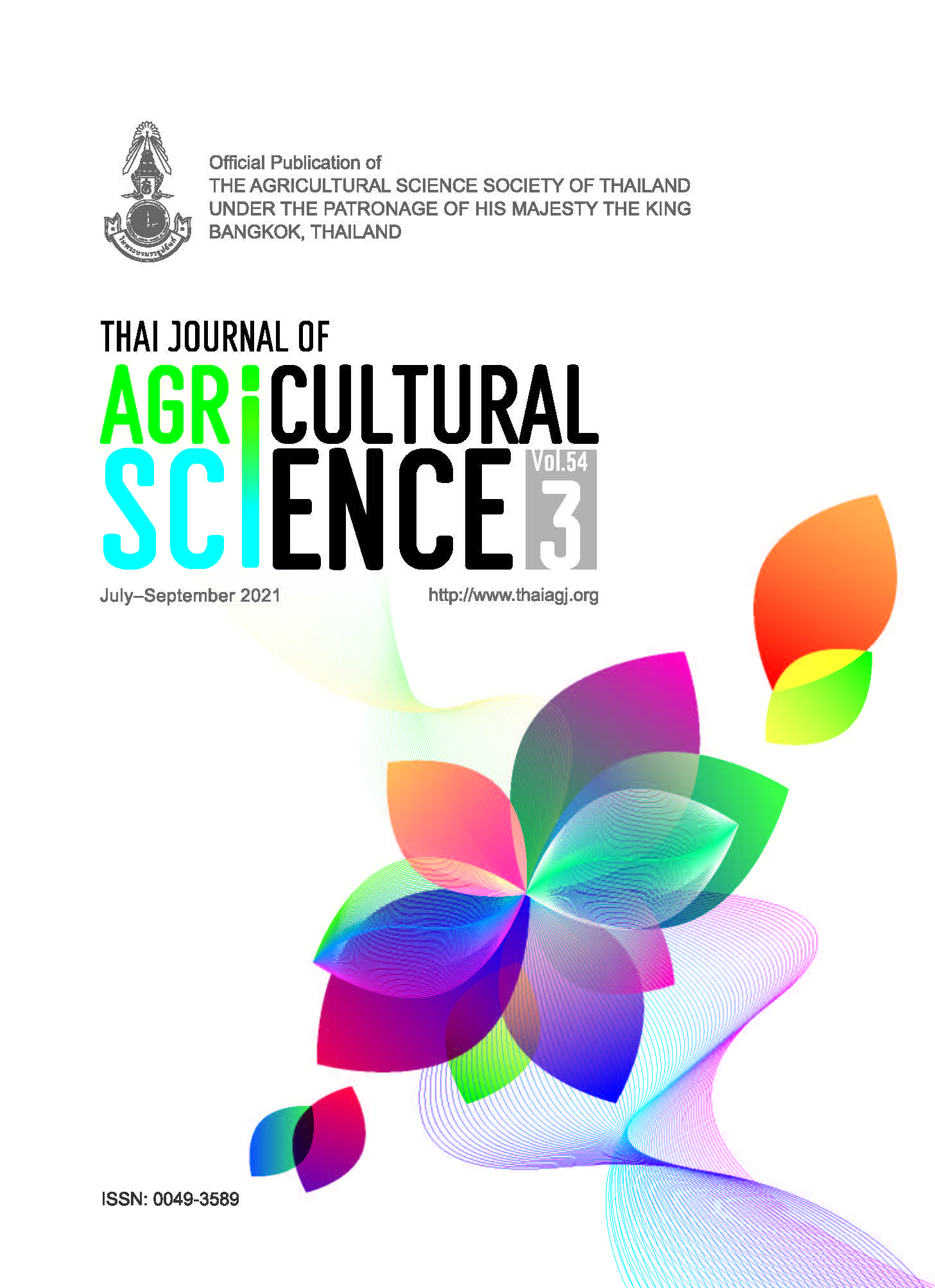Management of chilli insect pests by using trap crops
Main Article Content
Abstract
The field study was conducted at Spices Research Centre, Bangladesh Agricultural Research Institute (BARI), Bangladesh during Rabi season to evaluate the effectiveness of trap cropping with tomato, groundnut, French bean, carrot, and marigold with chilli for the management of chilli insect pests. Chilli (Capsicum frutescens L.) (BARI Morich-2) were protected by trap cropping with tomato, groundnut, French bean, carrot, and marigold. Among the different trap crops, chilli protected by trap cropping with marigold and tomato performed well by recording lowest population of sucking pests, leaf curl index, larval population of Helicoverpa armigera and Spodoptera litura with fruit damage. Whereas the highest pest population of aphids (Myzus persicae), thrips (Scirtothrips dorsalis), mite (Polyphagotarsonemus latus), leaf curl index, number of larvae per plant of H. armigera (Noctuidae: Lepidoptera) and S. litura (Noctuidae: Lepidoptera) with percent of fruit damage was observed in pure chilli crop (control). Yield data revealed that treatment chilli protected by trap cropping with marigold recorded highest red ripe chilli yield of 11.70 t/ha and it was statistically similar to treatment chilli protected by trap cropping with tomato (11.30 t/ha) and chilli protected by trap cropping with carrot (9.57 t/ha) whereas, trap crop yield was higher in chilli + tomato (22.80 t/ha) followed by chilli + French bean (12.62 t/ha) and chilli + carrot (12.05 t/ha). Among the different trap crops, the highest marginal benefit-cost ratio (24.53) was recorded from chilli + marigold, followed by chilli + tomato (20.71), chilli + carrot (17.86), and chilli + groundnut (10.76) whereas chilli + French bean trap crop recorded lowest marginal benefit-cost ratio (7.99). It appeared that growing trap crops between main crop and border crops was found advantageous in the management of different sucking and borer insect pests of chilli besides yield benefits.
Article Details

This work is licensed under a Creative Commons Attribution-NonCommercial-NoDerivatives 4.0 International License.
References
BBS (Bangladesh Bureau of Statistics). 2017. Statistical Year Book of Bangladesh. Statistics and Informatics Division, Ministry of Planning, Government of the People’s Republic of Bangladesh, Dhaka, Bangladesh.
Berke, T. and S.C. Shieh. 2000. Chilli peppers in Asia. Capsicum and Eggplant Newsletter. 19: 38–41.
Blaser, B.C., J.W. Singer and L.R. Gibson. 2007. Winter cereal, seeding rate and intercrop seeding rate effect on red clover yield and quality. Agron. J. 99(3): 723–729.
Boucher, T.J., R. Ashley, R. Durgy, M. Sciabarrasi and W. Calderwood. 2003. Managing the pepper maggot (Diptera: Tephritidae) using perimeter trap cropping. J. Econ. Entomol. 96: 420–432.
Clifton, N.P. and A. Duphily. 2006. New England winter squash profile. Available Source: http://www.pronewengland.org/INFO/PROpubs/Profile/WinterSquashProfile2006-04-14.pdf.
Dey, P.K, P.K. Sarkar and A.K. Somchoudhury. 2001. Efficacy of different treatment schedules of profenofos against major pests of chilli. Pestology. 25(11): 26–29.
Duraimurugan, P. and A. Regupathy. 2005. Push-pull strategy with trap crops, neem and nuclear polyhedrosis virus for insecticide resistance management in Helicoverpa armigera (Hubner) in cotton. Am. J. Applied Sci. 2(6): 1042–1048.
Dutta, N.K, M. Mahmudunnabi, K. Begum, A. Ferdous and S.N. Alam. 2014. Development of a Management Approach Against Sucking Pests of Brinjal. Annual Report 2013-14. Entomology Division, Bangladesh Agricultural Research Institute, Gazipur, Bangladesh.
Giraddi, R.S., M.S. Smitha and B.B. Channappagoudar. 2003. Organic amendments for the management of chilli (cv Byadagi kaddi) insect pests and their influence on crop vigour, pp. 361–365. In: Proceedings of the National Seminar on Perspective in Spices, Medicinal and Aromatic Plants, 27–29 November 2003, Goa, India.
Gomez, K.A. and A.A. Gomez. 1984. Statistical Procedures for Agricultural Research. 2nd Edition. John Wiley & Sons, Inc., New York, Chichester, Brisbane, Toronto, Singapore.
Gundannavar, K.P. and R.S. Giraddi. 2007. Management of chilli fruit borer, Helicoverpa armigera (Hübner). Pest Management in Horticultural Ecosystems. 13(1): 51–62.
Gundannavar, K.P., R.S. Giraddi, K.A. Kulkarni and J.S. Awaknavar. 2007. Development of integrated pest management modules for chilli pests. Karnataka J. Agric. Sci. 20(4): 757–760.
Hosamani, A.C. 2007. Management of Chilli Murda Complex in Irrigated Ecosystem. PhD Thesis, University of Agricultural Sciences, Dharwad, Karnataka, India.
Hussain, B. and S. Bilal. 2007. Marigold as a trap crop against tomato fruit borer (Lepidoptera:Noctuidae). Int. J. Agric. Res. 2(2): 185–188.
Maharjan, R., C. Jung and L. Kafle. 2013. Feasibility of the trap cropping system for the management of hemipteran bugs on mungbean, Vigna radiata (L.) Wilczek in Nepal. Formosan Entomol. 33: 15–26.
Majumdar, A. 2010. Trap Crops for Managing Vegetable Insect Pests. Entomology Series. Timely Information Agriculture & Natural Resources, Alabama Cooperative Extension System, USA.
Mallikarjuna Rao, D. and Ahmed. 1986. Effect of synthetic pyrethroids and other insecticides on the resurgence of chilli yellow mite, Polyphagotarsonemus latus Banks, pp 73–77. In: S. Jayaraj, (Ed), Proceeding of the National Symposium on Resurgence of Sucking Pests, Tamil Nadu Agricultural University, Coimbatore, India.
Mallikarjuna Rao, N., G. Muralidhara Rao and K. Tirumala Rao. 1999. Efficacy of neem products and their combinations against Aphis gossypi Glover on chillies. Andhra Agric. J. 46: 122–123.
Niles, G.A. 1980. Breeding cotton for resistance to insect pests, pp. 337–369. In: F.G. Mac Well and P.R. Jennings, (Eds), Breeding Plant Resistance to Insects. John Wiley & Sons, Inc., New York, USA.
Puttarudraiah, M. 1959. Short review on the leaf curl complex and spray programme for its control. Mysore J. Agric. Sci. 34: 93–95.
Reddy, D.N.R. and R. Puttaswamy. 1984. Pest infesting chilli (Capsicum annuum L.) in the transplanted crop. Mysore J. Agric. Sci. 19: 236–237.
Reddy, M.R.S. and G.S. Reddy. 1999. An eco-friendly method to combat Helicoverpa armigera (Hub.). Insect Environ. 4: 143–144.
SRC (Spices Research Centre). 2010. Chilli production technology, pp. 42–43. In: Spices Production Technology Manual. Bangladesh Agriculture Research Institute, Bogra, Bangladesh.
Tillman, P.G. and B.G. Mullinix. 2004. Effect of prey species on plant feeding behavior by the big-eyed bug, Geocoris punctipes (Say) (Heteroptera: Geocoridae), on cotton. Environ. Entomol. 32(6): 1399–1403.
Vaiyapuri, K., M.M. Amanullah, S. Pazhanivelan, E. Somasundaram and K. Sthykyanoonthi. 2007. Influence of intercropping unconventional green manures on pest incidence and yield of cotton. J. Appl. Sci. Res. 3(12): 1710–1716.


